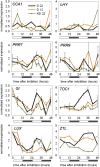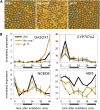A role for multiple circadian clock genes in the response to signals that break seed dormancy in Arabidopsis
- PMID: 19542296
- PMCID: PMC2714941
- DOI: 10.1105/tpc.108.064022
A role for multiple circadian clock genes in the response to signals that break seed dormancy in Arabidopsis
Abstract
Plant seeds can sense diverse environmental signals and integrate the information to regulate developmental responses, such as dormancy and germination. The circadian clock confers a growth advantage on plants and uses environmental information for entrainment. Here, we show that normal circadian clock gene function is essential for the response to dormancy-breaking signals in seeds. We show that mutations in the clock genes LATE ELONGATED HYPOCOTYL, CIRCADIAN CLOCK ASSOCIATED1 (CCA1), and GIGANTEA (GI) cause germination defects in response to low temperature, alternating temperatures, and dry after-ripening. We demonstrate that the transcriptional clock is arrested in an evening-like state in dry seeds but rapidly entrains to light/dark cycles in ambient temperatures upon imbibition. Consistent with a role for clock genes in seed dormancy control, CCA1 expression is transcriptionally induced in response to dry after-ripening and that after-ripening affects the amplitude of subsequent transcriptional clock gene oscillations. Control of abscisic acid- and gibberellin-related gene expression in seeds requires normal circadian function, and GI and TIMING OF CAB EXPRESSION1 regulate the response to ABA and GA in seeds. We conclude that circadian clock genes play a key role in the integration of environmental signaling controlling dormancy release in plants.
Figures








References
-
- Ali-Rachedi, S., Bouinot, D., Wagner, M.H., Bonnet, M., Sotta, B., Grappin, P., and Jullien, M. (2004). Changes in endogenous abscisic acid levels during dormancy release and maintenance of mature seeds: Studies with the Cape Verde Islands ecotype, the dormant model of Arabidopsis thaliana. Planta 219 479–488. - PubMed
-
- Bryant, T.R. (1972). Gas exchange in dry seeds: Circadian rhythmicity in the absence of DNA replication, transcription, and translation. Science 178 634–636. - PubMed
-
- Cao, S., Ye, M., and Jiang, S. (2005). Involvement of GIGANTEA gene in the regulation of the cold stress response in Arabidopsis. Plant Cell Rep. 24 683–690. - PubMed
Publication types
MeSH terms
Substances
Associated data
- Actions
- Actions
- Actions
- Actions
- Actions
- Actions
- Actions
- Actions
Grants and funding
LinkOut - more resources
Full Text Sources
Molecular Biology Databases
Research Materials

